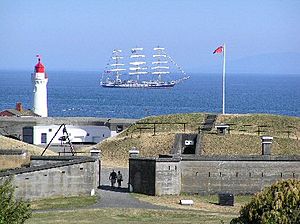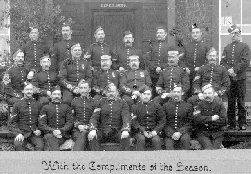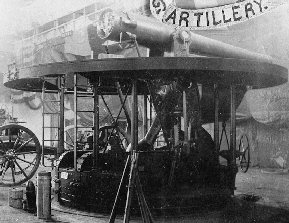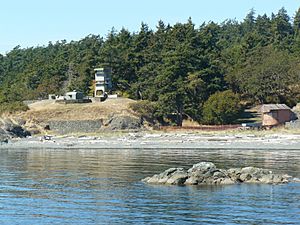Fort Rodd Hill National Historic Site facts for kids
Quick facts for kids Fort Rodd Hill |
|
|---|---|

View of the Strait of Juan de Fuca from the Lower Battery
|
|
| Location | Colwood, British Columbia, Canada |
| Built | 1895–1897 |
| Original use | Military Fortification |
| Governing body | Parks Canada |
| Official name: Fort Rodd Hill National Historic Site | |
| Designated | 3 November 1958 |
Fort Rodd Hill National Historic Site is an old fort from the 1800s. It sits on Esquimalt Harbour in Colwood, British Columbia, Canada. This fort was built in the 1890s by the Royal Marine Artillery. Its main job was to protect the important Esquimalt Naval Base.
The fort has three main gun areas, called batteries. Soldiers from the Royal Canadian Artillery used it continuously until 1956. Today, Fort Rodd Hill is right next to the Fisgard Lighthouse National Historic Site. This lighthouse was the very first one on Canada's west coast. Both the fort and the lighthouse are now managed by Parks Canada for everyone to visit and learn from.
Contents
Exploring Fort Rodd Hill's Past
Why Was Fort Rodd Hill Built?
Rodd Hill got its name from John Rashleigh Rodd, a naval officer. He was a First Lieutenant on a ship called HMS Fisgard. Guns were first placed here in 1864 to help protect Esquimalt Harbour.
The British Royal Navy started using Esquimalt Harbour in the 1840s. At first, it was just a place to anchor ships and get supplies. But it soon became an active naval base for the Royal Canadian Navy.
By 1862, the Royal Navy's Pacific Squadron moved its main base to Esquimalt. This meant more ships and buildings were there. Because of this, the base needed protection from possible attacks. Events like the Fraser River Gold Rush in 1858 and the Pig War made this need even clearer. These events caused tension with the United States.
Early Defenses and Concerns
After Vancouver Island joined British Columbia and then Canada, the first permanent defenses were built. In 1877, a conflict between Britain and Russia made people worry about the naval base. There were not enough defenses for Britain's only naval station on the west coast of North and South America.
Quickly, five gun batteries were built. They used large guns called 64-pounder naval rifled muzzle loaders. The biggest guns were at Macaulay Point and Brothers Island.
However, Admiral de Horsey, a naval commander, thought these defenses were not good enough. He felt there weren't enough trained gunners. He suggested a permanent group of 100 Royal Marine Artillery soldiers, modern guns, and underwater mines.
Building the Fort: A Big Project
The Canadian and British governments finally agreed on a defense plan in 1893. This agreement decided who would pay for what.
The British government agreed to provide:
- Guns, equipment, and supplies.
- Half the cost of building the defenses.
- Half the cost of keeping them running each year.
- A group of 75 Royal Marine Artillery soldiers.
Canada agreed to provide:
- All the land and buildings (except for the mine-laying equipment).
- Money to help pay for the Royal Marine Artillery soldiers.
- Half the cost of building the defenses.
- Half the cost of keeping them running each year.
- To train and grow the local army (militia).
The Royal Marine Artillery soldiers, who were specially trained, arrived in 1894. Royal Engineers also came to help build the permanent defenses.
Between 1894 and 1897, two forts were built. One was at Macaulay Point. The other, Fort Rodd Hill, was a new location overlooking the entrance to Esquimalt harbour.
The Amazing Disappearing Guns
Both forts had three special 6-inch "disappearing guns." At Fort Rodd Hill, two guns were in the "Lower Battery." The third gun was in a separate "Upper Battery" on a higher hill.
These guns were placed in concrete areas that were 10 feet thick. The concrete was protected by the rock of the hillside. The gun barrels were usually kept hidden in a "down" position. This protected them from enemy fire.
When it was time to fire, a special hydraulic system would lift the heavy 5-tonne barrel up. It would rise over the wall, fire, and then drop back down to reload. This meant the gun was only exposed to the enemy for a very short time. It was very hard for enemy ships to hit them.
These guns used "non-fixed ammunition." This means the explosive part and the shell were loaded separately. There were different types of shells, like high explosive, armor-piercing, and shrapnel. They all weighed 94 pounds and were 6 inches wide.
Other Defenses at Fort Rodd Hill
Besides the large disappearing guns, smaller, faster guns were also placed. These were meant to stop quick, unarmored torpedo boats. At Fort Rodd, the Belmont Battery had two quick-firing 12-pounder guns. These guns were helped by powerful searchlights. The searchlights were powered by diesel engines hidden in an engine room.
For very heavy attacks, larger 9.2-inch guns were built at Signal Hill. This was on the other side of Esquimalt harbour. These guns were so powerful that when they fired, they sometimes broke windows in the nearby village!
In 1899, a larger group of soldiers, the Royal Garrison Artillery, took over from the Royal Marine Artillery. Canadian soldiers also trained here and became very skilled. They even won national shooting competitions.
Fort Rodd Hill in the 20th Century
By the time of the Second World War, the original guns at Fort Rodd Hill were very old. In 1944, new, modern 6-pounder guns were installed.
In 1958, Fort Rodd Hill was recognized as a National historic site of Canada. This means it's a special place that helps us remember Canada's past. In 1985, Canada Post even put Fort Rodd Hill on a postage stamp!
See also




